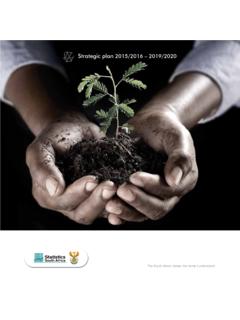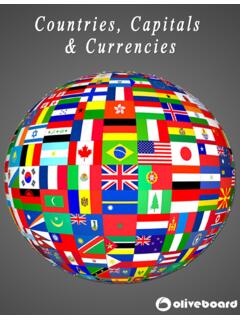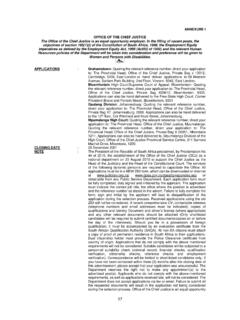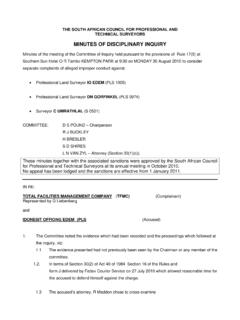Transcription of World reference base for soil resources 2014
1 106 World reference base for soil resources 2014 International soil classification system for naming soils and creating legends for soil mapsUpdate 2015 WORLDSOILRESOURCESREPORTSISSN 0532-0488 Copies of FAO publications can be requested from:Cover photographs (left to right): Ekranic Technosol Austria ( Erika Mich li)Reductaquic Cryosol Russia ( Maria Gerasimova)Ferralic Nitisol Australia ( Ben Harms)Pellic Vertisol Bulgaria ( Erika Mich li)Albic Podzol Czech republic ( Erika Mich li)Hypercalcic Kastanozem Mexico ( Carlos Cruz Gaistardo)Stagnic Luvisol South Africa ( M rta Fuchs)SALES AND MARKETING GROUPI nformation DivisionFood and Agriculture Organization of the United Nations Viale delle Terme di Caracalla00100 Rome, ItalyE-mail: (+39) 06 57053360 Web site.
2 reference base for soil resources 2014 International soil classification system for naming soils and creating legends for soil mapsUpdate 2015 FOOD AND AGRICULTURE ORGANIZATION OF THE UNITED NATIONSRome, 2015 WORLDSOIL RESOURCESREPORTS106 The designations employed and the pr esentation of material in this information pr oduct do not imply the expression of any opinion whatsoever on the part of the Food and Agriculture Organization of the United Nations (F AO) concerning the legal or development status of any country, territory, city or ar ea or of its authorities, or concerning the delimitation of its fr ontiers or boundaries. The mention of specific companies or pr oducts of manufacturers, whether or not these have been patented, does not imply that these have been endorsed or recommended by FAO in pr eference to others of a similar nature that ar e not views expressed in this information pr oduct ar e those of the author(s) and do not necessarily reflect the views or policies of 978-92-5-108369-7 (print)E-ISBN 978-92-5-108370-3 (PDF) FAO, 2014 FAO encourages the use, reproduction and dissemination of material in this information Recommended citation:IUSS Working Group WRB.
3 2015. World reference Base for Soil resources 2014, update 2015 International soil classification system for naming soils and creating legends for soil maps. World Soil resources Reports No. 106. FAO, oduct. Except where otherwise indicated, material may be copied, downloaded and printed for private study, research and teaching purposes, or for use in non-commercial pr oducts or services, pr ovided that appropriate acknowledgement of FAO as the source and copyright holder is given and that FAO s endorsement of users views, pr oducts or services is not implied in any requests for translation and adaptation rights, and for resale and other commercial use rights should be made via or addressed to information pr oducts ar e available on the FAO website ( ) and can be purchased through vAcknowledgementsviList of acronyms viiChapter 1.
4 Background and Major changes in WRB The object classified in the WRB Basic principles Architecture Topsoils Translation into other languages 11 Chapter 2. The rules for classifying soils and creating map General Rules for classifying Rules for creating map legends Subqualifiers Buried soils 21 Chapter 3. Diagnostic horizons, properties and materials22 Diagnostic horizons22 Diagnostic properties61 Diagnostic materials 76 Chapter 4. Key to the reference Soil Groups 85 with lists of principal and supplementary qualifiersChapter 5. Definitions of Qualifiers 117 References 140 Annex 1. Description, distribution, use and 144 management of reference Soil GroupsivAnnex 2. Summary of analytical procedures for soil characterization 182 Annex 3.
5 Recommended codes for the reference Soil Groups, 187 qualifiers and specifiers Annex 4. Soil particle-size and texture classes 192vForewordThe first edition of the World reference Base for Soil resources (WRB) was released at the 16th World Congress of Soil Science at Montpellier in 1998. At the same event, it was also endorsed and adopted as the system for soil correlation and international communication of the International Union of Soil Sciences (IUSS). The second edition of the WRB was released at the 18th World Congress at Philadelphia in 2006. After an additional eight years of intensive worldwide testing and data collection, the third edition of the WRB is presented. This publication builds on and reflects the valuable work of the authors of the earlier drafts and editions of the WRB, as well as the experiences and contributions of many soil scientists who participated in the work of the IUSS Working Group on the WRB is a soil classification system for naming soils and creating soil map legends.
6 It is hoped that this publication will contribute to the understanding of soil science in the general public and in the scientific publication has been made possible by the sustained efforts of a large group of expert authors, as well as the cooperation and logistic support of the IUSS and the Food and Agriculture Organization of the United Nations (FAO).Peter Schad (Chair) Cornie van Huyssteen (Vice-Chair) Erika Mich li (Secretary) IUSS Working Group WRBR onald Vargas Land and Water Development Division Food and Agriculture Organization of the United Nations (FAO)viAcknowledgementsThis edition has been compiled under the leadership of Peter Schad (Technische Universit t M nchen, Freising, Germany), Cornie van Huyssteen (University of the Free State, bloemfontein , South Africa) and Erika Mich li (Szent Istv n University, G d ll , Hungary).
7 The fundamental decisions have been made by the members of the WRB Board: L cia Anjos (Brazil), Carlos Cruz Gaistardo (Mexico), Seppe Deckers (Belgium), Stefaan Dondeyne (Belgium), Einar Eberhardt (Germany), Maria Gerasimova (Russia), Ben Harms (Australia), Arwyn Jones (European Commission), Pavel Krasilnikov (Russia), Thomas Reinsch (United States of America), Ronald Vargas (FAO), and Ganlin Zhang (China). Language editing was performed by Ben Harms (Australia).The current third edition received contributions from many scientists, among them are: David Badia Villas (Spain), Frank Berding (The Netherlands), Hans-Peter Blume (Germany), Vanda Buivydaite (Lithuania), Wolfgang Burghardt (Germany), Przemys aw Charzynski (Poland), Joe Chiaretti (United States of America), Juan Comerma (Venezuela), Carmelo Dazzi (Italy), Mahmut Dingil (Turkey), Arnulfo Encina Rojas (Paraguay), M rta Fuchs (Hungary), Luise Giani (Germany), Sergey Goryachkin (Russia), Alfred Hartemink (United States of America), Juan Jos Iba ez Mart (Spain), Plamen Ivanov (Bulgaria), Reinhold Jahn (Germany), Jer me Juilleret (Luxembourg), Cezary Kaba a (Poland), Andrzej Kacprzak (Poland), Arno Kanal (Estonia)
8 , Nikolay Khitrov (Russia), Roger Langohr (Belgium), Xavier Legrain (Belgium), Andreas Lehmann (Germany), Peter L scher (Switzerland), Gerhard Milbert (Germany), Brian Murphy (Australia), Freddy Nachtergaele (FAO), Otmar Nestroy (Austria), ge Nyborg (Norway), Tatiana Prokofieva (Russia), David Rossiter (The Netherlands), Daniela Sauer (Germany), Jaroslava Sobock (Slovakia), Karl Stahr (Germany), Leigh Sullivan (Australia), Wenceslau Teixeira (Brazil), ukasz Uzarowicz (Poland).The Working Group is greatly indebted to two brilliant soil scientists who made tremendous contributions to the development of the WRB and have sadly passed away.
9 Rudi Dudal (Belgium, 1926 2014) was the lead author of the Soil Map of the World , and Otto Spaargaren (The Netherlands, 1944 2015) was for a long time the leading scientist of the WRB Working , the Working Group wishes to express its gratitude to the FAO for its support and for making possible the printing and distribution of this of acronymsAldith Aluminium extracted by a dithionite-citrate-bicarbonate solutionAlox Aluminium extracted by an acid ammonium oxalate solutionAlpy Aluminium extracted by a pyrophosphate solutionCaCO3 Calcium carbonateCEC Cation exchange capacityCOLE Coefficient of linear extensibilityEC Electrical conductivityECe Electrical conductivity of saturation extractESP Exchangeable sodium percentageFAO Food and Agriculture Organization of the United NationsFedith Iron extracted by a dithionite-citrate-bicarbonate solutionFeox Iron extracted by an acid ammonium oxalate solutionFepy
10 Iron extracted by a pyrophosphate solutionHCl Hydrochloric acid ISRIC International Soil reference and Information CentreISSS International Society of Soil ScienceIUSS International Union of Soil SciencesKOH Potassium hydroxideKCl Potassium chlorideMndith Manganese extracted by a dithionite-citrate-bicarbonate solutionNaOH Sodium hydroxideNH4 OAc Ammonium acetateODOE Optical density of the oxalate extractRSG reference Soil GroupviiiSAR Sodium adsorption ratioSiox Silicon extracted by an acid ammonium oxalate solutionSiO2 SilicaSUITMA Soils in Urban, Industrial, Traffic, Mining and Military Areas (IUSS working group)TRB Total reserve of basesUNESCO United Nations Educational, Scientific, and Cultural OrganizationUSDA United States Department of AgricultureWRB World reference Base for Soil Resources1 Chapter 1 - Background and basicsChapter 1 Background and HiSToRyFrom its beginnings to the second edition 2006 The World reference Base (WRB) is based on the Legend (FAO-Unesco, 1974) and the Revised Legend (FAO, 1988) of the Soil Map of the World (FAO-Unesco, 1971-1981).
















